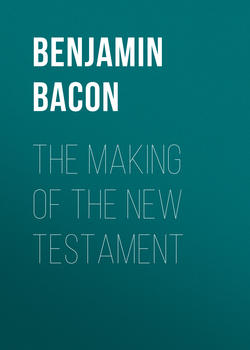The Making of the New Testament

Реклама. ООО «ЛитРес», ИНН: 7719571260.
Оглавление
Bacon Benjamin Wisner. The Making of the New Testament
PART I. CANONIZATION AND CRITICISM
CHAPTER I. INSPIRATION AND CANONIZATION
CHAPTER II. THE REACTION TO CRITICISM
PART II. THE LITERATURE OF THE APOSTLE
CHAPTER III. PAUL AS MISSIONARY AND DEFENDER OF THE GOSPEL OF GRACE
CHAPTER IV. PAUL AS PRISONER AND CHURCH FATHER
CHAPTER V. PSEUDO-APOSTOLIC EPISTLES
PART III. THE LITERATURE OF CATECHIST AND PROPHET
CHAPTER VI. THE MATTHÆAN TRADITION OF THE PRECEPTS OF JESUS
CHAPTER VII. THE PETRINE TRADITION. EVANGELIC STORY
CHAPTER VIII. THE JOHANNINE TRADITION. PROPHECY
PART IV. THE LITERATURE OF THE THEOLOGIAN
CHAPTER IX. THE SPIRITUAL GOSPEL AND EPISTLES
CHAPTER X. EPILOGUES AND CONCLUSIONS
BIBLIOGRAPHY
Отрывок из книги
The New Testament presents the paradox of a literature born of protest against the tyranny of a canon, yet ultimately canonized itself through an increasing demand for external authority. This paradox is full of significance. We must examine it more closely.
The work of Jesus was a consistent effort to set religion free from the deadening system of the scribes. He was conscious of a direct, divine authority. The broken lights of former inspiration are lost in the full dawn of God's presence to His soul.
.....
It is long before the sense of present inspiration, both in word and work is lost; still longer before the recorded precepts of Jesus, the exhortations and directions of apostles, the visions of "prophets," come to take their place alongside the Bible of the synagogue as "writings of the new covenant." Melito of Sardis (c. 170) is the first to use this expression, and even in his case it does not bear the sense of a canon with definite limits. Tertullian (200-210) is the first to place a definite "New Testament" over against the Old. We must glance at some of the intermediate steps to appreciate this gradual process of canonization.
At first there is no other 'Scripture' than the synagogue's. Clement of Rome (95) still uses only the Law and the Prophets (including certain apocrypha now lost) as his Bible. He refers to the precepts of Jesus (quoted as in Acts xx. 35 from oral tradition), with the same sense as Paul of their paramount authority, and bids the Corinthians whom he addresses give heed to what the blessed Apostle Paul had written to them "in the beginning of the gospel service," to warn them against factiousness. Nor has Clement yet lost the sense of direct inspiration; for he attaches to his own epistle, written in behalf of the church at Rome, the same superhuman authority claimed in Acts xv. 28 for the letter sent by the church at Jerusalem. If the Corinthians disregard the "words spoken by God through us" they will "incur no slight transgression and danger," for these warnings of a sister church are uttered in the name and by inspiration of the Holy Ghost. Still, Clement does not dream of comparing his authority, even when he writes as agent of the church, with that of "the oracles of the teaching of God," the "sacred Scriptures," the "Scriptures which are true, which were given through the Holy Ghost, wherein is written nothing unrighteous or counterfeit." He does not even rank his own authority with that of "the good apostles, Peter and Paul."
.....